Related Research Articles

A submarine is a watercraft capable of independent operation underwater. It differs from a submersible, which has more limited underwater capability. The term is also sometimes used historically or colloquially to refer to remotely operated vehicles and robots, as well as medium-sized or smaller vessels, such as the midget submarine and the wet sub. Submarines are referred to as boats rather than ships irrespective of their size.

Signals intelligence (SIGINT) is the act and field of intelligence-gathering by interception of signals, whether communications between people or from electronic signals not directly used in communication. Signals intelligence is a subset of intelligence collection management. As classified and sensitive information is usually encrypted, signals intelligence may necessarily involve cryptanalysis. Traffic analysis—the study of who is signaling to whom and in what quantity—is also used to integrate information, and it may complement cryptanalysis.
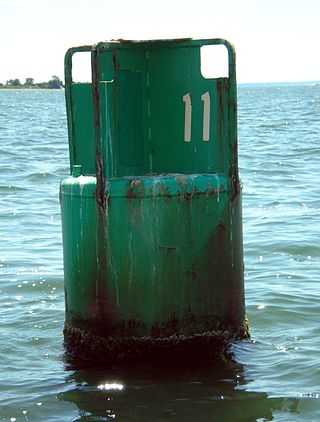
A buoy is a floating device that can have many purposes. It can be anchored (stationary) or allowed to drift with ocean currents.
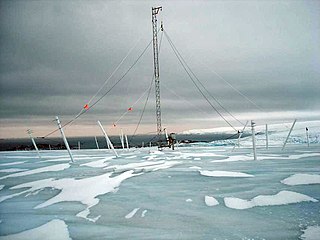
Very low frequency or VLF is the ITU designation for radio frequencies (RF) in the range of 3–30 kHz, corresponding to wavelengths from 100 to 10 km, respectively. The band is also known as the myriameter band or myriameter wave as the wavelengths range from one to ten myriameters. Due to its limited bandwidth, audio (voice) transmission is highly impractical in this band, and therefore only low data rate coded signals are used. The VLF band is used for a few radio navigation services, government time radio stations and for secure military communication. Since VLF waves can penetrate at least 40 meters (131 ft) into saltwater, they are used for military communication with submarines.
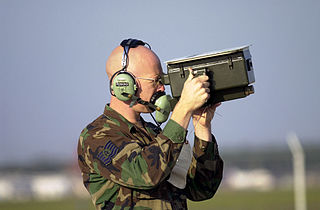
Identification, friend or foe (IFF) is a combat identification system designed for command and control. It uses a transponder that listens for an interrogation signal and then sends a response that identifies the broadcaster. IFF systems usually use radar frequencies, but other electromagnetic frequencies, radio or infrared, may be used. It enables military and civilian air traffic control interrogation systems to identify aircraft, vehicles or forces as friendly, as opposed to neutral or hostile, and to determine their bearing and range from the interrogator. IFF is used by both military and civilian aircraft. IFF was first developed during World War II, with the arrival of radar, and several friendly fire incidents.
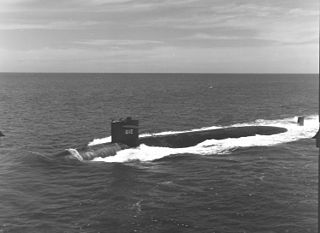
USS Guardfish (SSN-612), a Thresher-class submarine, was the second ship of the United States Navy to be named for the guardfish, a voracious green and silvery fish with elongated pike-like body and long narrow jaws.

The SEAL Delivery Vehicle (SDV) is a crewed submersible and a type of swimmer delivery vehicle used to deliver United States Navy SEALs and their equipment for special operations missions. It is operated by SEAL Delivery Vehicle Teams.

An electronic countermeasure (ECM) is an electrical or electronic device designed to trick or deceive radar, sonar, or other detection systems, like infrared (IR) or lasers. It may be used both offensively and defensively to deny targeting information to an enemy. The system may make many separate targets appear to the enemy, or make the real target appear to disappear or move about randomly. It is used effectively to protect aircraft from guided missiles. Most air forces use ECM to protect their aircraft from attack. It has also been deployed by military ships and recently on some advanced tanks to fool laser/IR guided missiles. It is frequently coupled with stealth advances so that the ECM systems have an easier job. Offensive ECM often takes the form of jamming. Self-protecting (defensive) ECM includes using blip enhancement and jamming of missile terminal homers.
Communication with submarines is a field within military communications that presents technical challenges and requires specialized technology. Because radio waves do not travel well through good electrical conductors like salt water, submerged submarines are cut off from radio communication with their command authorities at ordinary radio frequencies. Submarines can surface and raise an antenna above the sea level, or float a tethered buoy carrying an antenna, then use ordinary radio transmissions; however, this makes them vulnerable to detection by anti-submarine warfare forces.

A sonobuoy is a small expendable sonar buoy dropped from aircraft or ships for anti-submarine warfare or underwater acoustic research. Sonobuoys are typically around 13 cm (5 in) in diameter and 91 cm (3 ft) long. When floating on the water, sonobuoys have both a radio transmitter above the surface and hydrophone sensors underwater.
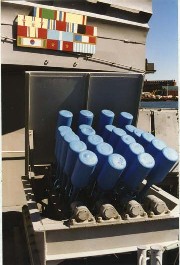
An anti-submarine weapon (ASW) is any one of a number of devices that are intended to act against a submarine and its crew, to destroy (sink) the vessel or reduce its capability as a weapon of war. In its simplest sense, an anti-submarine weapon is usually a projectile, missile or bomb that is optimized to destroy submarines.

The automatic identification system (AIS) is an automatic tracking system that uses transceivers on ships and is used by vessel traffic services (VTS). When satellites are used to receive AIS signatures, the term Satellite-AIS (S-AIS) is used. AIS information supplements marine radar, which continues to be the primary method of collision avoidance for water transport. Although technically and operationally distinct, the ADS-B system is analogous to AIS and performs a similar function for aircraft.

Anti-submarine warfare is a branch of underwater warfare that uses surface warships, aircraft, submarines, or other platforms, to find, track, and deter, damage, or destroy enemy submarines. Such operations are typically carried out to protect friendly shipping and coastal facilities from submarine attacks and to overcome blockades.

Naval tactics and doctrine is the collective name for methods of engaging and defeating an enemy ship or fleet in battle at sea during naval warfare, the naval equivalent of military tactics on land.

Anti-surface warfare is the branch of naval warfare concerned with the suppression of surface combatants. More generally, it is any weapons, sensors, or operations intended to attack or limit the effectiveness of an adversary's surface ships. Before the adoption of the submarine and naval aviation, all naval warfare consisted of anti-surface warfare. The distinct concept of an anti-surface warfare capability emerged after World War II, and literature on the subject as a distinct discipline is inherently dominated by the dynamics of the Cold War.

The bathythermograph, or BT, also known as the Mechanical Bathythermograph, or MBT; is a device that holds a temperature sensor and a transducer to detect changes in water temperature versus depth down to a depth of approximately 285 meters. Lowered by a small winch on the ship into the water, the BT records pressure and temperature changes on a coated glass slide as it is dropped nearly freely through the water. While the instrument is being dropped, the wire is paid out until it reaches a predetermined depth, then a brake is applied and the BT is drawn back to the surface. Because the pressure is a function of depth, temperature measurements can be correlated with the depth at which they are recorded.

Multiservice tactical brevity codes are codes used by various military forces. The codes' procedure words, a type of voice procedure, are designed to convey complex information with a few words.

Project Sanguine was a US Navy project proposed in 1968 for communication with submerged submarines using extremely low frequency (ELF) radio waves. The initially proposed system, hardened to survive a nuclear attack, would have required a giant antenna covering two-fifths of the state of Wisconsin. The proposed approach was never implemented because of protests and potential environmental impact. A smaller, less hardened system called Project ELF consisting of two linked ELF transmitters located at Clam Lake, Wisconsin 46°05′05.6″N90°55′03.7″W and Republic, Michigan 46°20′10.1″N87°53′04.6″W was built beginning in 1982 and operated from 1989 until 2004. The system transmitted at a frequency of 76 Hz. At ELF frequencies, the bandwidth of the transmission was very small, so the system could only send short-coded text messages at a very low data rate. These signals were used to summon specific vessels to the surface to receive longer operational orders by ordinary radio or satellite communication.
Naval Radio Transmitter Facility Aguada is a tall guyed radio mast erected by the United States Navy. It is used as a facility of the US Navy for ashore and U.S. and NATO ships, planes, and submarines operating at sea in areas of broadcast coverage near Aguada, Puerto Rico at 18°23′55″N67°10′38″W by using radio waves in the very low frequency range.

Naval tactics play a crucial role in modern battles and wars. The presence of land, changing water depths, weather, detection and electronic warfare, the speed at which actual combat occurs and other factors – especially air power – have rendered naval tactics essential to the success of any naval force.
References
- Tactics 101: Anti-Submarine Warfare (ASW) - Part 2, 2009
- Douglas Savage: Incident in Mona Passage: A Novel , Taylor Trade Publishing, 2014, ISBN 978-1-58979-848-9
- Michael DiMercurio: Phoenix Sub Zero , Crossroad Press, 2017, ISBN 978-1-55611-392-5
- Michael DiMercurio: Threat Vector , Crossroad Press, 2017, ISBN 978-0-45140-908-9
- Michael DiMercurio: Barracuda Final Bearing , Crossroad Press, 2017, ISBN 978-1-55611-458-8
- Tom Clancy, John Gresham: Submarine: A Guided Tour Inside a Nuclear Warship , Penguin, 2003, ISBN 978-1-10100-258-2